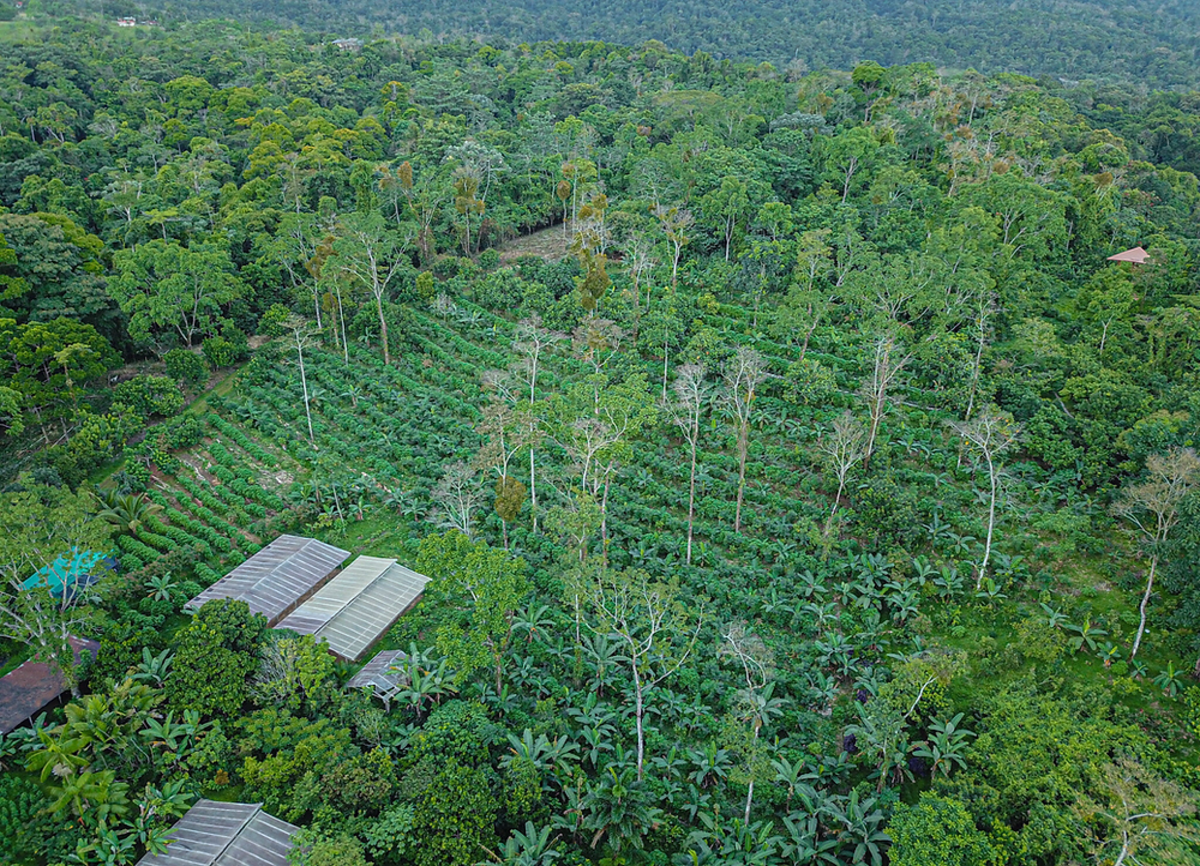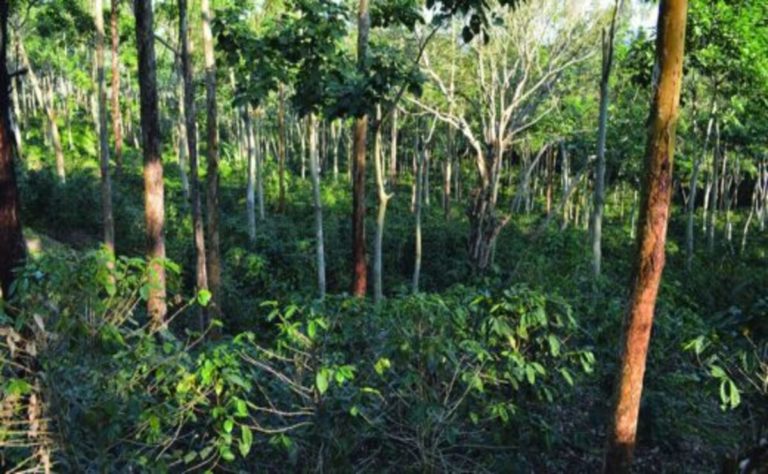Syntropic Agroforestry : Nurturing Resilient Farms through Biodiversity
Syntropic agroforestry is a fascinating approach to farming that mimics the way plants grow in natural ecosystems. In traditional farming, big fields of a single crop are common. But in syntropic agroforestry, different types of plants are encouraged to grow together in harmony. We’ll talk about the basics of syntropic agroforestry in this article. We’ll look at its benefits and how it can change the way sustainable agriculture is done.
Principles of Syntropic Agroforestry
Syntropic agroforestry is a way of farming that tries to make farming systems work like natural environments and help different plant types get along. The main ideas behind syntropic agroforestry are these:
Mimicking Natural Ecosystems:
Concept: : Syntropic agroforestry is based on making farms work like natural environments do The farming method attempts to reproduce this natural synergy by monitoring and understanding how plants grow together in forests.
Diverse Plant Selection:
Concept: On a vast area syntropic agroforestry emphasizes the development of a many variety of plants rather than producing a single type of crop .
Importance: When we grow diverse plant its contribute to a resilient and balanced ecosystem. These differents plants have roles, such as providing shade, fixing nitrogen in the soil, and attracting beneficial insects.
Successional Planting:
Concept: When we plants strategically and successively in stages, we are actualy allowing for a progression of different species to dominate the system at different times. This approach mirrors the natural growth patterns seen in forests.
Importance: For maintaining ecosystem successional planting always helps . Different plants thrive in different stages of growth, promoting biodiversity and maximizing resource utilization.
Biomass Integration:
Concept: Utilization of every plant parts, including branches and leaves, into biomass production. Subsequently, this biomass is reintegrated into the system, thereby encouraging nutrient cycling and preserving soil health.
Importance: Biomass integration diminishes reliance on external inputs by transforming the organic matter produced by the plants into a valuable resource integrated into the agricultural system. It improves the structure and fertility of the soil.
Collectively, these principles establish a sustainable and harmonious agroforestry system. In an effort to maximize resource utilization, enhance ecological resilience, and promote soil health, syntropic agroforestry uses successional planting, diversity promotion, and biomass integration. Frequently, farmers who embrace these principles observe heightened levels of productivity, enhanced environmental sustainability, and increased resilience in the face of shifting climatic conditions.
Key Components of Syntropic Agroforestry
Syntropic agroforestry is a method of cultivation that establishes a harmonious and fruitful ecosystem through the deliberate integration and selection of diverse plant components. The fundamental constituents of syntropic agroforestry comprise:
Canopy Trees:
- Role: Tall, overarching trees that provide shelter and establish a protective canopy over the entire system are known as canopy trees.
- Functions: They provide habitat for birds and beneficial insects, contribute organic matter to the soil via leaf litter, and offer shade to the vegetation below.
- Examples: Fruit or nut trees with broad canopies, such as mango, avocado, or chestnut trees.
Sub-Canopy and Shrubs:
- Role: Situated lower than the canopy, sub-canopy vegetation contribute to the nutrient cycling and biodiversity of the system as a whole.
- Functions: These plants make the landscape more interesting, bring in different kinds of wildlife, and help keep the soil healthy by moving nutrients.
- Examples: Berry bushes, nitrogen-fixing shrubs, or flowering plants that support pollinators.
Herbaceous Layer:
- Role: Ground cover plants that grow close to the soil top make up the herbaceous layer. This layer protects the soil.
- Functions: Ground cover plants keep the soil from washing away, keep weeds down, and add organic matter to the soil when they die.
- Examples: Cover crops can be low-growing herbs, legumes, or grasses.
Vines and Climbers:
- Role: Climbers and vines that grow on trees or trellises help the agroforestry system make use of vertical room.
- Functions: They add to the variety of life, give animals more places to live, and can provide fruits or other edible parts.
- Examples: Passionfruit vines, grapevines, or climbing beans.
- Root Crops:
- Role: Certain root crops can be integrated into the system, growing beneath the soil surface.
- Functions: Root crops contribute to soil structure, add to the diversity of edible produce, and help in nutrient cycling.
- Examples: Sweet potatoes, yams, or radishes.
Beneficial Insectary Plants:
- Role: Plants that attract beneficial insects play a crucial role in pest management within the agroforestry system.
- Functions: These plants provide nectar, pollen, or habitat for insects that assist in pollination and control harmful pests.
- Examples: Marigolds, lavender, or other flowering plants.
By picking and putting these parts together with care, farmers can make an agroforestry system that can last for a long time and support biodiversity, soil health, and general sustainability. Every part of the syntropic agroforestry method is important for its success in its own way.
Benefits of Syntropic Agroforestry
There are many benefits to syntropic agroforestry that help make farms more sustainable and resilient. Some of the best reasons to use syntropic agroforestry are listed below:
Increased Biodiversity:
Benefit: Syntropic agroforestry encourages the cultivation of diverse plant species, creating a rich and varied ecosystem.
Explanation: Having different plants around brings in many helpful bugs, birds, and other animals, which makes the environment healthy and more balanced.
Soil Health Improvement:
Benefit: The system enhances soil fertility and structure naturally.
Explanation: A variety of plants, along with biomass integration and organic matter recycling, help the earth hold on to nutrients, stop it from washing away, and lower the need for outside fertilizers.
Climate Resilience:
- Benefit: Syntropic agroforestry systems are more adaptable to changing weather conditions.
- Explanation: The variety of plants and the system’s complicated structure make it more resilient, which means farms are less likely to be damaged by extreme weather and the effects of climate change.
Sustainable Yield:
- Benefit: The combination of diverse crops and natural nutrient cycling leads to sustainable and consistent harvests.
- Explanation: Syntropic agroforestry systems are made to be productive over a long period of time. They do this by lowering the need for outside inputs and increasing the yield over time.
Reduced Need for External Inputs:
Benefit: Syntropic agroforestry minimizes reliance on synthetic fertilizers and pesticides.
Explanation: Because the system is self-sustaining and uses biomass and biodiversity to help control pests naturally, it doesn’t need as many chemicals from outside sources.
Enhanced Ecosystem Services:
- Benefit: Syntropic agroforestry contributes to a range of ecosystem services.
- Explanation: The system gives good bugs a place to live, helps the soil hold on to water, and supports ecological balance, which makes the farm’s input to the environment stronger.
Community and Economic Benefits:
- Benefit: Syntropic agroforestry can have positive social and economic impacts.
- Explanation: Syntropic agroforestry can help communities stay strong and farms stay profitable in the long run by promoting sustainable practices, increasing local biodiversity, and making soil healthier.
Carbon Sequestration:
Benefit: The system helps capture and store carbon in the soil and biomass.
Explanation: Agroforestry that encourages the growth of trees and plants is called syntropic agroforestry. It works as a carbon sink, taking carbon out of the air and storing it.
As a whole, syntropic agroforestry is an environmentally friendly and whole-systems method to farming that has benefits beyond just growing crops. Because ecological principles are used, it shows promise for long-lasting and reliable farming methods.
Case Studies
Syntropic agroforestry is being used successfully by farms all over the world. These real-life examples show how this method can be changed to work in different climates and situations. They can help farmers who want to make their methods more environmentally friendly.
Challenges and Solutions
There are many good things about syntropic agroforestry, but there are also some bad things, like having to deal with bugs and pests. But these problems can be solved with good planning, education, and community participation.
Future Trends in Syntropic Agroforestry
More farmers will likely use syntropic agroforestry as study and technology improve and as global efforts to support sustainable farming grow. It might be possible to make the food system more sustainable by applying these ideas to regular farming.
Conclusion
Syntropic agroforestry is a simple but effective way to deal with the problems that modern agriculture faces. Farmers can make farms that are healthier, more resilient, and last longer if they work with nature instead of against it. These farms will help both the environment and the people they serve. It’s a call to action for farming that is more peaceful and long-lasting.
Also Read:







